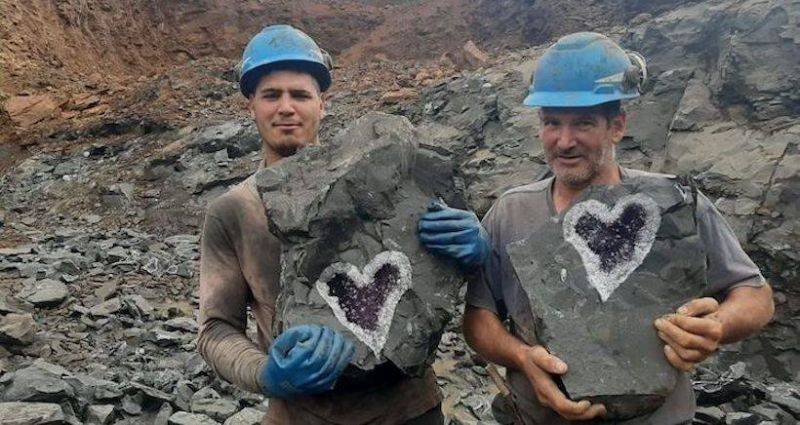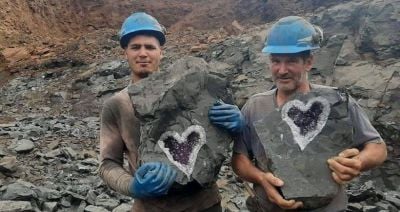
Workers pose with the amethyst-lined geode. (Credit: DR)
Shaped by the magical work of nature, this gemstone has aroused the desire of some of the greatest collectors to have it for themselves, but Selim Edde managed to bring it to the MIM museum, the mineral and fossil museum in Beirut.
This stone originated from the Santa Rosa mine in Uruguay’s Artigas region, which borders Brazil.
“It is a treasure! It is the first time we discover something like that,” Marcos Lorenzelli, director of Uruguay Minerals, a company dedicated to the processing and exportation of semi-precious stones, told My Modern Met.
On the excavation day, the miners struggled because the rock was considerably harder than usual, and it took them several hours to break it open. But the result was truly an exceptional discovery.
The basalt geode (which is a rock with a cavity lined with crystals) revealed a heart-shaped amethyst divided in two parts, which had been hidden for millions of years in the bowels of the Earth.
The story captivated internet users and quickly went viral.
Two sides, two hearts
The hearts are outlined with a contour consisting of pure quartz, but due to the high iron content of the silicon which makes up the quartz at their center, it is covered with amethyst crystals, Edde explained.
He noted that this geode “has no equivalent. It is a unique natural occurrence, amid thousands of amethyst pockets excavated from this deposit. Also, as luck would have it, the basalt broke open in the right spot, yielding a pocket filled with amethyst with one heart on the left and another on the right. Had it been cracked on the sides, the hearts would have gone, and we would never have known of their existence. I purchased the two sides. A well-known American merchant got his hands on it and told me about this discovery. I admit that I was reluctant in the beginning, because there are already a large number of amethysts in our collection. But when my colleagues, Suzy Hakimian and Carole Atallah, and my siblings saw the photo, they all replied that it would be insane to miss out on such a masterpiece.”
The hearts are currently showcased, in their original state, at MIM museum.
This set is perfect for romantics, and above all for passionate mineral lovers.
Other rare and eye-catching pieces have been recently obtained by the MIM museum. They include a vivianite from Brazil, which is an iron phosphate that comes in a translucent emerald green color. According to experts, it results from boiling water on fossilized dinosaur carcasses, which dissolved the phosphate of the bones, thus forming an exquisite sheave of bright green crystals that have an incredible contrast with the earth tone colors.
Beryl, which also originates from Brazil, comes in the form of hexagonal crystals, smooth or ribbed. “It is a mineral that I once loved so much, and I finally got enough,” Edde said.
However, he could not resist an amazing set of seven beryls showing their brilliance side by side: milky white quartz, yellow topaz, orthoclase, morganite, aka angel stone, in pink “peach blossom,” as well as other crystals that try to seduce the large-sized rocket-shaped aquamarine.
The museum is also enriched by two magnificent sandstones, known as gogottes, from Fontainebleau-Rambouillet, south-west of Paris.
“The silica-laden water cemented the ultra-fine sand together, and gave it the wave shape,” Edde said.
The studies conducted on the dating of calcite that is included in the gogottes of that area reveal that they were formed during two major periods, the first ranges between 30 million and 50 million years ago, and the second dates back to 300 million years ago.
“These 3-D objects bring to mind modern art sculptures. Some remind me of Bibendum, the Michelin tire man,” Edde said.
The size, the whiteness, the fineness of sand grains, and their perfect form, had also charmed the Sun King, France’s Louis XIV.
The museum is designed to preserve precious “pebbles,” including tourmalines, calcite, quartz, pyrite and rhodonite, and other rare and unique species, including spangolite, geocronite and parahopeite, which were formed millions of years ago.
The fine balance between the specimens sought after by specialists, who recognize their scientific dimensions, and the spectacular pieces appreciated by an increasingly larger audience makes this private museum one of the most beautiful and complete in the world.
The name of the Lebanese collector Edde also appears in a book entitled “Les Minéraux Remarkables” [Remarkable Minerals] by Jean-Claude Boulliard, curator of the prestigious Sorbone collection (Pierre-et-Marie Curie University) in Paris.
Each of the 2,500 pieces at the museum is unique in its own way. They are part of a valuable inventory of the planet's mineral diversity. And beyond their beauty, there is the fabulous story of the mineral universe that each piece tells. Their historical value is priceless, since many of them come from mines or deposits that no longer exist. They are the memory of the Earth and constitute a real heritage for mankind.
This article was originally published in French in L'Orient-Le Jour. Translation by Joelle El Khoury.
